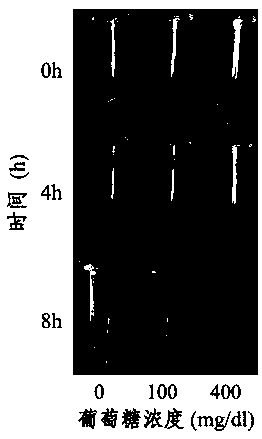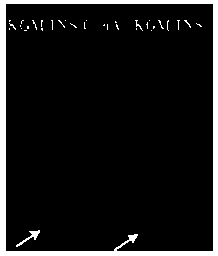Insulin-loaded nanoparticles and application thereof
A nanoparticle, loaded technology, applied in the field of insulin loaded nanoparticles, can solve problems such as poor patient compliance, and achieve the effect of good thermal stability and uniform size
- Summary
- Abstract
- Description
- Claims
- Application Information
AI Technical Summary
Problems solved by technology
Method used
Image
Examples
Embodiment 1
[0082] Example 1 Preparation of Nanoparticles
[0083] 1. Experimental operation
[0084] Prepare 5 mg / ml KGM solution, take 2 ml KGM solution, add 1 mg insulin, and mix well.
[0085] Prepare 5mg / ml ConA solution, take 1.88ml ConA solution, add 100μL KCl solution (0.1 M), 10μL CaCl 2 Solution (0.01 mM), 10μL of MnCl 2 Solution (0.01 mM), finally get 2ml mixed solution, ConA solution, KCl solution, CaCl in the whole system 2 Solution, MnCl 2 The molar concentration ratio of the solution is 9.8×10 4 : 1×10 4 :1:1. Shake at a constant speed for 6 h at room temperature.
[0086] Add 2ml of the activated ConA solution and the cross-linking agent sodium trimetaphosphate to the solution dissolved with KGM and insulin so that the final concentration of the cross-linking agent sodium trimetaphosphate is 0.125 mg / ml. Shake well at 4℃ for 1 h . Then the solution was placed in 120ml PBS solution (pH 6.8) and magnetically stirred for 4 h. KGM and ConA were cross-linked to form insulin-loaded na...
Embodiment 2
[0089] Example 2 Glucose Sensitive Detection of Particles
[0090] 1. Experimental operation
[0091] The KGM-INS-ConA nanoparticles prepared in Example 1 were placed in glucose solutions of different concentrations (0 mg / dl, 100 mg / dl, 400 mg / dl) for in vitro release. Observe the dissolution and release of particles by centrifugation at three time points of 0 h, 4 h, and 8 h, and take pictures for observation.
[0092] 2. Experimental results
[0093] Such as figure 1 It shows that the structure of KGM-INS-ConA nanoparticles undergoes reversible loose or tight changes when the glucose concentration increases or decreases.
[0094] KGM-INS-ConA nanoparticles were added to glucose solutions of different concentrations (0 mg / dl, 100 mg / dl, 400 mg / dl), and it was observed that the particles in the glucose solutions of different concentrations were at 0 h, 4 h, 8 The amount of dissolution increased in different degrees at h (such as figure 2 ). Comparing the dissolution of particles in ...
Embodiment 3
[0095] Example 3 Nanoparticle precipitation comparison
[0096] 1. Experimental operation
[0097] The KGM-INS-ConA nanoparticles and KGM-INS nanoparticles prepared in Example 1 were centrifuged (5000 rpm) to collect the precipitate and observe
[0098] 2. Experimental results
[0099] Obvious white precipitates can be seen in the KGM-INS-ConA nanoparticle centrifuge tube, and there is almost no white precipitate in the same position of the KGM-INS nanoparticle centrifuge tube (such as image 3 ). It can be seen that, due to the specific binding between KGM and ConA, KGM-INS-ConA nanoparticles loaded with insulin are formed. Without ConA, KGM cannot be combined with it, and there is almost no obvious formation of nanoparticles. This indicates that the cross-linking of ConA and KGM can form a carrier for insulin transport, and ConA is an important raw material for preparing insulin-loaded nanoparticles.
PUM
| Property | Measurement | Unit |
|---|---|---|
| particle diameter | aaaaa | aaaaa |
| particle size | aaaaa | aaaaa |
| particle size | aaaaa | aaaaa |
Abstract
Description
Claims
Application Information
 Login to View More
Login to View More - R&D
- Intellectual Property
- Life Sciences
- Materials
- Tech Scout
- Unparalleled Data Quality
- Higher Quality Content
- 60% Fewer Hallucinations
Browse by: Latest US Patents, China's latest patents, Technical Efficacy Thesaurus, Application Domain, Technology Topic, Popular Technical Reports.
© 2025 PatSnap. All rights reserved.Legal|Privacy policy|Modern Slavery Act Transparency Statement|Sitemap|About US| Contact US: help@patsnap.com



